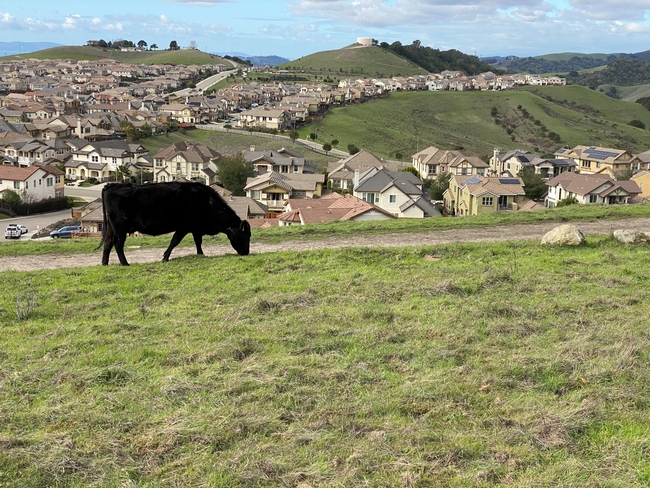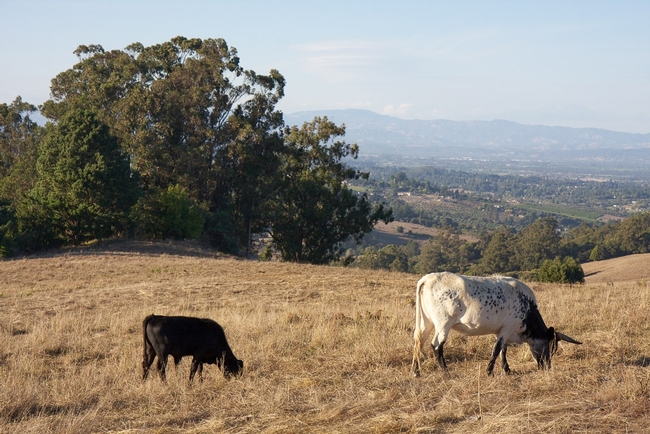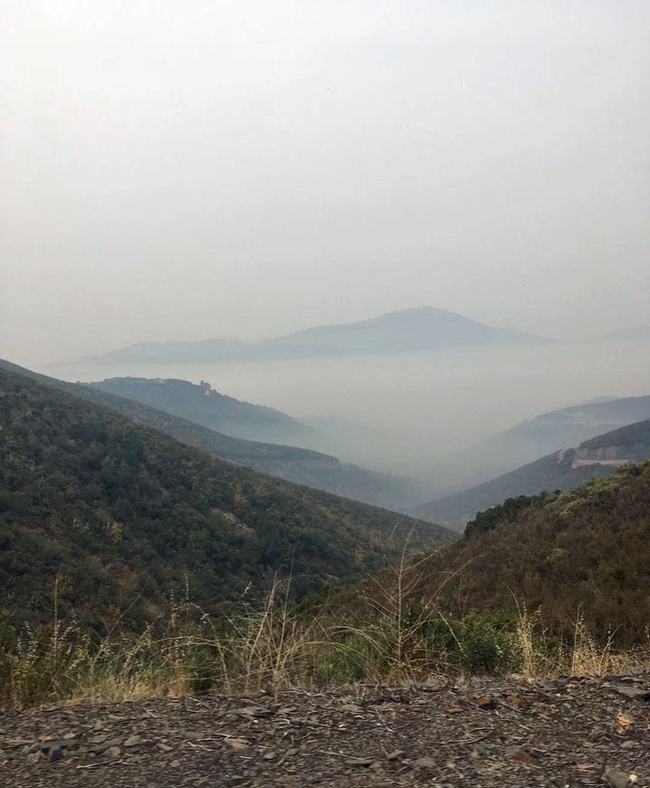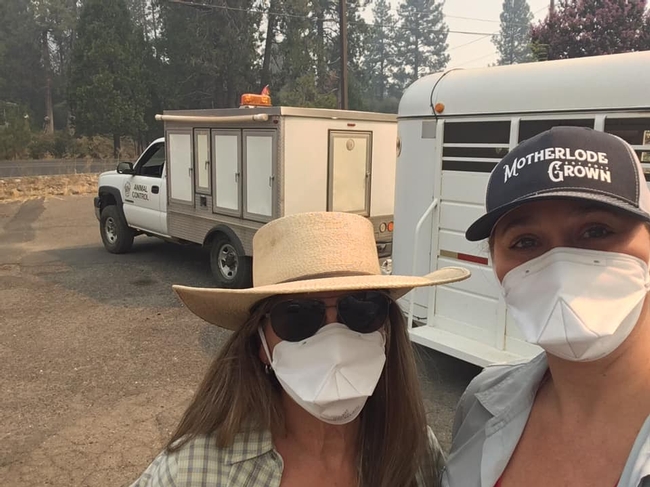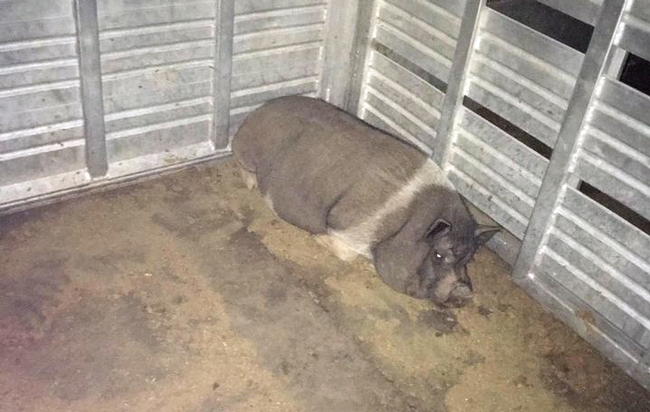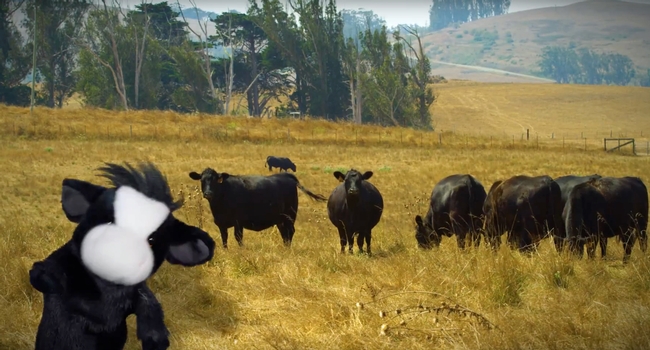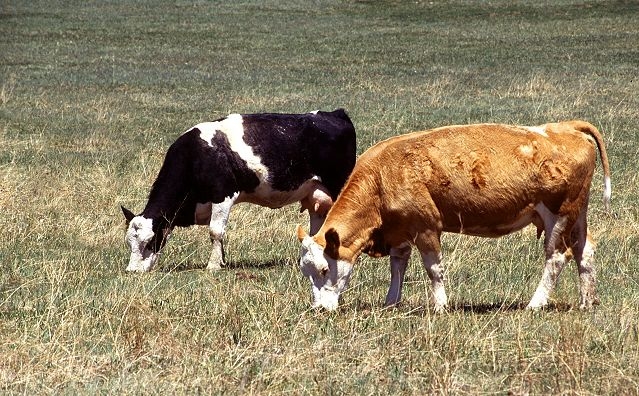Posts Tagged: Sheila Barry
New UC ANR publication educates public on cycles of cattle production, grazing and economics
The pandemic has brought more people into nearby parks and public lands for hiking, biking and other recreational activities. In areas like the East Bay Regional Parks – a San Francisco Bay Area park system totaling more than 120,000 acres where about 65% of the land is grazed by livestock – visitors might see goats, sheep and, most likely, cattle.
Those encounters with animals (or their manure) represent a prime opportunity for members of the public to learn about agriculture and the ecological benefits of rangelands, according to Larry Forero, a UC Cooperative Extension livestock and natural resources advisor.
As livestock grazing (mostly by beef cattle) constitutes a significant portion of land use across the state, Forero – along with fellow UCCE advisors Sheila Barry and Stephanie Larson – recently authored a UC Agriculture and Natural Resources publication summarizing the mechanics of cattle production.
“Beef Cattle on California Annual Grasslands: Production Cycle and Economics,” published in October and available as a free download on the UC ANR Catalog, describes the seasonal phases of cattle production and the factors that impact ranchers' financial calculations and management decisions.
“This concise publication walks through annual stock flows and calendar of operations and gives tables for estimating costs, return over cash, and gross income under various scenarios,” said Forero.
“Even if only a relatively small percentage of park goers are interested, you still touch a lot of people with a document like this,” Forero explained.
He said he hopes park signage and QR codes will direct visitors to the publication for more information about the cattle and their seasonal movements.
“People often wonder where the cattle go when they leave the park and when they will return,” co-author Sheila Barry said. “The cattle may go to grass or feed yards in other places in California or even out of state.”
But, as this new UC ANR publication explains, the cattle production cycle turns over anew.
“There will be more cattle next fall, I promise,” Barry said.
Cattle grazing is a tool for reducing fire danger
Cattle can help reduce wildfire danger by grazing on fine fuels in rangeland and forest landscapes, reported Sierra Dawn McClain in Capital Press. The article also appeared in the Blue Mountain Eagle, the Westerner and the East Oregonian.
The article cited the preliminary results of research by UC Cooperative Extension that show that cattle consumed approximately 12.4 billion pounds of forage across California in 2017. The researchers believe the cattle could do more.
Many grazable acres aren't grazed, said Sheila Barry, UCCE livestock and natural resources advisor in Santa Clara, San Mateo, Alameda and Contra Costa counties. According to the Capital Press article, Barry said the public doesn't always recognize the benefits of grazing; they see short grass and cow patties. Cattle's role in preventing wildfires is often overlooked.
Devii Rao, UCCE livestock and natural resources advisor for San Benito, Monterey and Santa Cruz counties and the study's lead, said ranchers should target grazing around homes, infrastructure, roadsides and at the wildland-urban interface.
“There are so many things we can do better. Cattle grazing is really important to fire safety, and it's time we have more conversations about it,” Rao said.
UC Cooperative Extension springs into action to aid wildfire recovery
After the destructive LNU Complex Fire burned through farms and ranches where Morgan Doran lives and works, he immediately volunteered to help families and local authorities take care of animal victims.
Doran, the UC Cooperative Extension livestock and natural resources advisor for Yolo, Napa, Solano and Sacramento counties, spent two full days the weekend of Aug. 22-23 in a truck with a county sheriff's deputy escort to search for live animals and provide information on how to handle dead livestock.
Nearly 300 animals – mainly horses, sheep, goats and alpacas – were killed during the LNU Complex Fire in Solano County. Some were hit by vehicles, others couldn't escape burning buildings.
“I helped locate animals that needed attention and shared burial and other disposal options and guidelines,” Doran said. He also created an online survey for dead or missing animal reporting.
Doran, also the director of UC Cooperative Extension in Sacramento, Solano and Yolo counties, and his staff and partner organizations – including the USDA Farm Service Agency, Natural Resources Conservation Districts, local resource conservation districts and county officials – have organized a free webinar to help local residents in fire recovery. The webinar is from 9 a.m. to 12:30 p.m. Thursday, Sept. 10. Pre-registration is required.
Topics to be covered are:
- Navigating the agency alphabet soup for disaster assistance
- Understanding wildland fire impacts
- Impact of fire on oak woodlands, what to expect and what to do
- Impact of fire on rangelands, what to expect and what to do
- Impact of fire on orchard trees, what to expect and what to do
- Impact of fire on vineyards and wine grapes, what to expect and what to do
- Erosion risks and mitigation measures
- USDA disaster programs and how to apply
Evacuating animals
In areas where the Moc Fire burned near Moccasin, Calif., UC Cooperative Extension 4-H advisor in the Central Sierra, JoLynn Miller, joined partners to activate Team ELITE (Evacuation of Livestock in Tuolumne Emergencies) so trained volunteers could help move animals to safety and ensure they are fed and housed during the wildfire.
The organization was established in the wake of the 2015 Butte Fire, when officials recognized the need for coordinated animal evacuation planning. They drafted Miller, an experienced horsewoman and community volunteer, to spearhead the group.
“We work closely with and are dispatched by animal control during an emergency,” Miller said. “Team ELITE requires members to be trained in incident command systems and they are sworn Disaster Service Workers once they complete a Team ELITE orientation and training. The Moc Fire was the first fire where we've done evacuations.”
Team ELITE was placed on standby on Aug. 20. A few hours later, three teams were behind the fire lines.
“Volunteers worked throughout the night to pick up animals,” Miller said. “The first night we had donkeys, chickens, horses, alpacas and pigs evacuated.” The animals were held at the Mother Lode Fairgrounds in Tuolumne County.
The team spent three days, Aug. 22-24, feeding and watering animals. Aug. 25 the evacuation orders were lifted and they helped families get their animals back home.
For more information about Team ELITE, see its Facebook page https://www.facebook.com/TeamELITEinformation/
Valuing the losses
Federal, county, CALFIRE and other officials routinely turn to UCCE experts to gather information about the impact of wildfire on agricultural lands.
Two UC Cooperative Extension rangeland advisors, Theresa Becchetti of Stanislaus and San Joaquin counties and Sheila Barry of San Mateo, Alameda, Santa Clara and Contra Costa counties, both cover areas burned by the SCU Fire.
In order for a disaster to be declared and for insurance payouts, a value must be attached to losses caused by the wildfire. In rangeland areas, components of the losses include hundreds of miles of fencing, forage, stock ponds and damage to the soil and seedbank that could impede grass growth for years. Livestock may also be lost in wildfires.
“In some respects, the SCU Fire was an invisible fire because it didn't threaten vineyards or redwoods – landscapes that get more attention. It is grassland, oak woodland and brushland. Some very small pockets of forest,” Barry said. “But it is actually the second largest fire in the state's history.”
Becchetti had previously developed a methodology for calculating forage losses. The two scientists were able to use the system for establishing the economic loss to ranchers and government agencies caused by the blaze. CALFIRE also used the information to inform the distribution of its firefighting resources.
“The Farm Service Agency has told us that the information we put together on the value of the area is enough for the local county committees to declare a disaster, which will release emergency cost share programs,” Becchetti said. “We are continuing conversations with the agencies in the four counties and starting to put information out for ranchers.”
UCCE will host meetings regarding fire recovery and disaster assistance programs. Visit local UC Cooperative Extension websites for details.
Videos show hikers how to avoid Black Friday stampedes on park trails
While Americans traditionally beat a path to the malls the day after Thanksgiving, many opt out of shopping on Black Friday to enjoy the outdoors. In regional parks and other open spaces, hikers may encounter crowds of a different sort – cattle grazing with their calves. A 1,200-pound cow blocking the path can be daunting.
With a little patience and understanding, people who hike, bike and horseback ride can coexist peacefully with the cattle, according to Sheila Barry, UC Cooperative Extension livestock and natural resources advisor in Santa Clara County.
For happier trails, UC Agriculture and Natural Resources has produced a series of videos that show hikers how they can amicably share open space with their beefy neighbors. In a two-minute video, a black cow puppet with a furry white face describes how to politely coax cows to moo-ove aside without spurring a Black Friday stampede.
“We wanted to produce videos that are entertaining as well as informative,” Barry said.
The cow pun-filled video also describes the ecosystem services cattle provide by consuming nearly their body weight in plants. By grazing, cows manage the vegetation, reducing wildfire fuel, increasing water capture and promoting the diversity of native grasses and wildflowers.
In “Sharing open spaces with livestock,” the UC Agriculture and Natural Resources livestock experts give four simple tips for safely sharing open space with cows on the trail:
- Keep moo-ving and speak in a normal tone. Sudden movements and loud noises may surprise cows.
- Approach cows from the side or front. They find it udderly unnerving to have someone sneak up from behind, the bovine blind spot.
- Steer clear of getting between a protective mother and her calf.
- If you need to move a cow, step slowly into its flight zone. Invading the animal's “personal space” will motivate it to mosey aside.
A second video, “Sharing open spaces with livestock when you have a dog,” gives advice for dog owners to keep their best friends safe around cows.
In a third video, “A year in the life of a cow,” the UC Cooperative Extension spokespuppet describes a typical year for a beef cow.
“The videos are a fun way to educate the public about grazing on rangelands,” said Stephanie Larson, UC Cooperative Extension livestock and rangeland advisor in Sonoma County.
The videos are based on the UC ANR publication “Understanding Working Rangelands,” authored by Barry and Larson, at http://ucanr.edu/shareopenspace.
Watch all three videos on UC ANR's YouTube channel:
Sharing open spaces with livestock https://youtu.be/Qd8LEGLDhaM
Sharing open spaces with livestock when you have a dog https://youtu.be/zzdGnfFwmcA
A year in the life of a cow https://youtu.be/znJbWknVXVg
Impact of grazing livestock on public lands under drought conditions
Poor management of grazed rangelands can "exacerbate the effect of drought," the report said.
The Forest Service identified the need to reduce cattle numbers on public land during a severe drought - in come cases to 50 or 70 percent of total carrying capacity, which is the number of animals the land can support before causing environmental degradation. Plants that have been overgrazed "are less able to recover after a drought," the report said.
For expert commentary, Danovich turned to a UC Agriculture and Natural Resources (UC ANR) source. Sheila Barry, the livestock and natural resources advisor for UC ANR Cooperative Extension, said ranchers do have to reduce herd size in times of extreme drought.
Cattle that graze on the open range are usually finished at a feed lot. In the first year of drought, ranchers have the option of weaning cattle early to reduce demands on the land without reducing the herd size. In the second year of drought, ranchers have to consider cutting into their herds. "As soon as they do that," Barry said, "it can take up to eight years to build it back."


